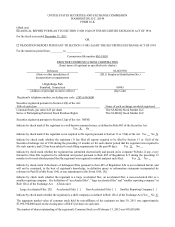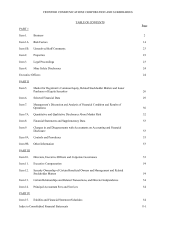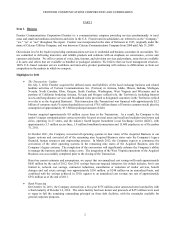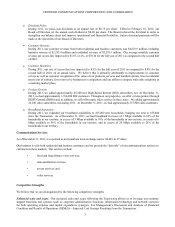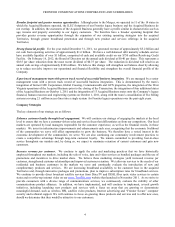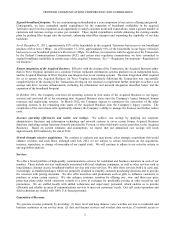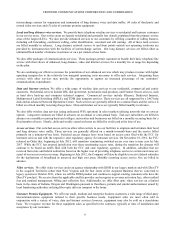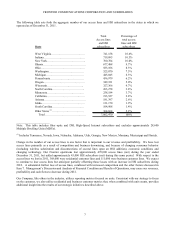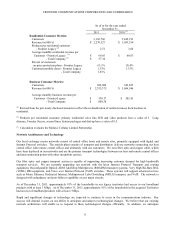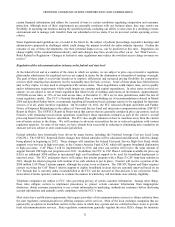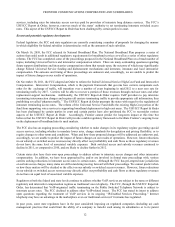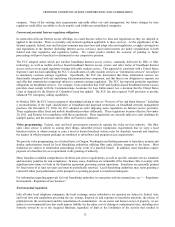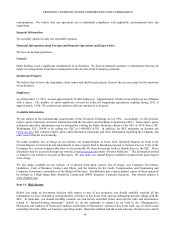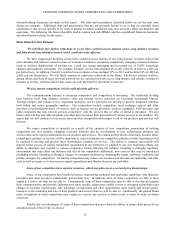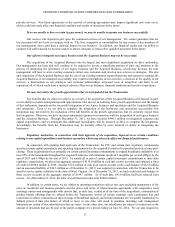Frontier Communications 2011 Annual Report Download - page 11
Download and view the complete annual report
Please find page 11 of the 2011 Frontier Communications annual report below. You can navigate through the pages in the report by either clicking on the pages listed below, or by using the keyword search tool below to find specific information within the annual report.
FRONTIER COMMUNICATIONS CORPORATION AND SUBSIDIARIES
8
As of or for the year ended
December 31,
2011 2010
(1)
Residential Customer Metrics:
Customers 3,103,766 3,445,193
Revenue (in 000’s) $ 2,270,527 $ 1,693,354
Products per residential customer
- Frontier Legacy (2)
2.72
2.60
Average monthly residential revenue per
Customer - Frontier Legacy (3)
- Total Company (3)
$ 60.65
$ 57.34
$ 60.03
Percent of customers
on price protection plans - Frontier Legacy
63.1%
58.4%
Customer monthly churn - Frontier Legacy
- Total Company
1.33%
1.61%
1.33%
Business Customer Metrics:
Customers 309,900 343,823
Revenue (in 000’s) $ 2,353,375
$ 1,606,546
Average monthly business revenue per
Customer - Frontier Legacy
- Total Company
$ 530.17
$ 600.38
$ 502.41
(1) Revised from the previously disclosed amounts to reflect the reclassification of certain revenues from business to
residential.
(2) Products per residential customer: primary residential voice line, HSI and video products have a value of 1. Long
distance, Frontier Secure, second lines, feature packages and dial-up have a value of 0.5.
(3) Calculation excludes the Mohave Cellular Limited Partnership.
Network Architecture and Technology
Our local exchange carrier networks consist of central office hosts and remote sites, primarily equipped with digital and
Internet Protocol switches. The outside plant consists of transport and distribution delivery networks connecting our host
central office with remote central offices and ultimately with our customers. We own fiber optic and copper cable, which
have been deployed in our networks and are the primary transport technologies between our host and remote central offices
and interconnection points with other incumbent carriers.
Our fiber optic and copper transport system is capable of supporting increasing customer demand for high bandwidth
transport services. We are currently upgrading our network with the latest Internet Protocol Transport and routing
equipment, Reconfigurable Optical ADM Add/Drop Multiplexers (ROADM) transport systems, Very High Bit-Rate DSL
(VDSL) HSI equipment, and Voice over Internet Protocol (VoIP) switches. These systems will support advanced service
such as Metro Ethernet, Dedicated Internet, Multiprotocol Label Switching (MPLS) transport, and VoIP. The network is
designed with redundancy and auto-failover capability on our major circuits.
As of December 31, 2011, approximately 91% of the households in our legacy territories had access to our broadband
products with at least 1 Mbps. As of December 31, 2011, approximately 81% of the households in the acquired Territories
had access to broadband products with at least 1 Mbps.
Rapid and significant changes in technology are expected to continue to occur in the communications industry. Our
success will depend, in part, on our ability to anticipate and adapt to technological changes. We believe that our existing
network architecture will enable us to respond to these technological changes efficiently. In addition, we anticipate


